Indira Gandhi International Airport
| Indira Gandhi International Airport इंदिरा गांधी अन्तर्राष्ट्रीय हवाई अड्डा Iṅdirā Gāṅdhī Aṅtarrāṣṭrīya Havāī Aḍḍā | |||||||||||||||||||
|---|---|---|---|---|---|---|---|---|---|---|---|---|---|---|---|---|---|---|---|
 | |||||||||||||||||||
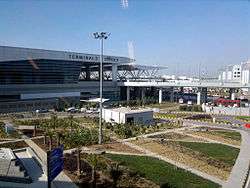 | |||||||||||||||||||
| IATA: DEL – ICAO: VIDP | |||||||||||||||||||
| Summary | |||||||||||||||||||
| Airport type | Public | ||||||||||||||||||
| Owner | Airports Authority of India | ||||||||||||||||||
| Operator | Delhi International Airport Private Limited (DIAL) | ||||||||||||||||||
| Serves | Delhi/NCR | ||||||||||||||||||
| Location | South West Delhi, Delhi, India | ||||||||||||||||||
| Hub for | |||||||||||||||||||
| Elevation AMSL | 777 ft / 237 m | ||||||||||||||||||
| Coordinates | 28°34′07″N 077°06′44″E / 28.56861°N 77.11222°ECoordinates: 28°34′07″N 077°06′44″E / 28.56861°N 77.11222°E | ||||||||||||||||||
| Website |
www | ||||||||||||||||||
| Map | |||||||||||||||||||
 DEL  DEL | |||||||||||||||||||
| Runways | |||||||||||||||||||
| |||||||||||||||||||
| Statistics (April 15- Nov 16[1]) | |||||||||||||||||||
| |||||||||||||||||||
Indira Gandhi International Airport (IATA: DEL, ICAO: VIDP) serves as the primary civilian aviation hub for the National Capital Region of Delhi, India. The airport, spread over an area of 5,106 acres (2,066 ha),[7] is situated in Palam, 15 km (9.3 mi) south-west of the New Delhi railway station and 16 km (9.9 mi) from New Delhi city centre.[8][9]
Named after Indira Gandhi, a former Prime Minister of India, it is the busiest airport in the country in terms of passenger traffic since 2009. It is busiest airport in the country in terms of cargo traffic in the recent year overtaking Mumbai during late 2015.[10]
With the commencement of operations at Terminal 3 in 2010, it became India's and South Asia's largest aviation hub, with a current capacity of handling more than 40 million passengers. The planned expansion program will increase the airport's capacity to handle 100 million passengers by 2030.[11] In 2015, the airport was the 25th busiest airport in the world by passenger traffic and 12th busiest airports in Asia, handling over 48 million passengers (a 18% growth in traffic over the previous year).
The airport was operated by the Indian Air Force before its management was transferred to the Airports Authority of India.[12] In May 2006, the management of the airport was passed over to Delhi International Airport Limited (DIAL), a consortium led by the GMR Group.[13]
In September 2008, the airport inaugurated a 4,430 m (14,530 ft) runway. The Terminal 3 building, which commenced operations in 2010, has a capacity to handle 34 million passengers annually. Terminal 3 is the world's 8th largest passenger terminal.[9] The airport uses an advanced system called Airport Collaborative Decision Making (A-CDM) to help keep takeoffs and landings timely and predictable.[14]
In 2010, IGIA was conferred the fourth best airport award in the world in the 15–25 million category, and Best Improved Airport in the Asia-Pacific Region by Airports Council International.[15] The airport was rated as the Best airport in the world in the 25–40 million passengers category in 2015, by Airports Council International.[16][17]
Delhi Airport was awarded The Best Airport in Central Asia and Best Airport Staff in Central Asia at the Skytrax World Airport Awards 2015.[18] IGI also stood first in the new rankings for 2015 Airport Service Quality (ASQ) Awards.[19]
History
Safdarjung Airport was built in 1930 and was the main airport for Delhi until 1962.[7] Due to increasing passenger traffic at Safdarjung, civilian operations were moved to Palam Airport (later renamed to IGIA) in 1962.[7] Palam Airport had been built during World War II as RAF Station Palam and after the British left, it served as an Air Force Station for the Indian Air Force. Palam Airport had a peak capacity of around 1,300 passengers per hour.[7] Owing to an increase in air traffic in the 1970s, an additional terminal with nearly four times the area of the old Palam terminal was constructed. With the inauguration of a new international terminal (Terminal 2), on 2 May 1986, the airport was renamed as Indira Gandhi International Airport (IGIA).[7]
On 31 January 2006, the aviation minister Praful Patel announced that the empowered Group of Ministers have agreed to sell the management-rights of Delhi Airport to the DIAL consortium and the Mumbai airport to the GVK Group.[20] On 2 May 2006, the management of Delhi and Mumbai airports were handed over to the private consortia.[21] Delhi International Airport Limited (DIAL) is a consortium of the GMR Group (54%), Fraport (10%) and Malaysia Airports (10%),[22][22] and the Airports Authority of India retains a 26% stake.[23]
Nine years later, in May 2015, Malaysia Airports chose it exit from DIAL venture and sold its entire 10% stake to majority share holder GMR Infra for $79 million. Following this GMR Group's stake at DIAL increased to 64%.[24] Earlier GMR indicated that it was interested in buying out the 10% stake of Fraport.[25]
The old domestic airport (Palam) is known as Terminal 1 and handles domestic flights for all budget airlines. The terminal is divided into three separate buildings – 1A (dedicated terminal for state-run Air India, no longer used), 1B (used by all private commercial airlines, now closed and demolished), the Domestic Arrival Terminal 1C and the newly constructed departure terminal 1D (now used by all domestic low-cost airlines (GoAir, IndiGo, SpiceJet). There is also a separate Technical Area for VVIP passengers. Additionally, there is a separate terminal for Hajj flights.
Significant growth in Indian aviation industry led to a major increase in passenger traffic. The capacity of Terminal 1 is estimated to be 7.15 million passengers per annum (mppa). Actual throughput for 2005/06 was an estimated 10.4 million passengers. Including the now-closed international terminal (Terminal 2), the airport had a total capacity of 12.5 million passengers per year, whereas the total passenger traffic in 2006/07 was 16.5 million passengers per year[26] In 2008, total passenger count at the airport reached 23.97 million.
Runways
_Interior_of_New_Delhi_Airport.jpg)
Delhi Airport has three near-parallel runways: runway 11/29, 4,430 m × 60 m (14,530 ft × 200 ft) with CAT IIIB instrument landing system (ILS) on both sides, runway 10/28, 3,810 m × 46 m (12,500 ft × 151 ft), and an auxiliary runway 09/27, 2,813 m × 45 m (9,229 ft × 148 ft). In addition to Allama Iqbal International Airport of Lahore, Pakistan,[27] Runway 10/28 and runway 11/29 of Delhi Airport are the only airports in South Asia to have been equipped with the CAT III-B ILS. In the winter of 2005 there were a record number of disruptions at Delhi airport due to fog/smog. Since then some domestic airlines have trained their pilots to operate under CAT-II conditions of a minimum 350 m (1,150 ft) visibility. On 31 March 2006, IGI became the first Indian airport to operate two runways simultaneously following a test run involving a SpiceJet plane landing on runway 28 and a Jet Airways plane taking off from runway 27 at the same time.
The initially proposed method of simultaneous takeoffs caused several near misses over the west side of the airport where the centrelines of runways 10/28 and 9/27 intersect. The runway use method was changed to segregate dependent mode from 25 December 2007, which was a few days after the deciding near miss involving an Airbus A330-200 of Qatar Airways and an Indigo A320 aircraft. The new method involved use of runway 28 for all departures and runway 27 for all arrivals. This method which was more streamlined was followed full-time till 24 September 2008.
On 21 August 2008, the airport inaugurated its 3rd runway 11/29 costing ₹10 billion[28] and 4,430 m (14,534 ft) long. The runway has one of the world's longest paved threshold displacements of 1,460 m (4,790 ft). This, in turn decreases the available landing length on runway 29 to 2,970 m (9,744 ft).
The purpose of this large threshold displacement is primarily to reduce noise generated by landing aircraft over nearby localities. The runway increases the airport's capacity to handle 85 flights from the previous 54–60 flights per hour. The new runway was opened for commercial operations on 25 September 2008. At present, runways 11/29 and 10/28 operate in mixed mode while runway 09/27 is used as a taxiway. During peak hours, all three runways will be operated simultaneously to reduce the stress on the airport's main runways 10/28 and 11/29.[29]
Terminals
IGI Airport serves as a major hub or a focus destination for several Indian carriers including Air India, Air India Regional, IndiGo, Jet Airways, SpiceJet, GoAir and Vistara. Approximately 80 airlines serve this airport. At present there are two active scheduled passenger terminals, a dedicated Hajj terminal and a cargo terminal.
Terminal 1
Terminal 1 is currently used by low cost carriers IndiGo, SpiceJet and GoAir.
- Terminal 1A
Terminal 1A was built in the early 1990s to cater to Indian Airlines. It had to be refurbished after a fire gutted the interiors and DIAL significantly upgraded the terminal. It was used by Air India Regional until it moved to the new Terminal 3 on 11 November 2010. The terminal is now closed and is expected to be torn down on the completion of newer terminals.
- Terminal 1C
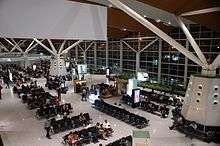
Terminal 1C is used only for domestic arrivals. The terminal has been upgraded with a new expanded greeting area and a larger luggage reclaim area with 8 belts.
- Terminal 1D
Terminal 1D is the newly built domestic departure terminal with a total floor space of 35,000 m2 (380,000 sq ft) and has a capacity to handle 10 million passengers per year. Terminal 1D commenced operations on 15 April 2009. It has 72 Common Use Terminal Equipment (CUTE) enabled check-in counters, 16 self check-in counters, and 16 security channels.
Terminal 2
Terminal 2 was opened on 1 May 1986, at a cost of ₹950 million[7] and was used for International flights until July 2010 when operations shifted to T3. The terminal now remains dormant for most of the year and is only used for special operations, such as Haj flights. DIAL plans to temporarily shift the domestic operations of SpiceJet and GoAir to T2 in order to revamp Terminal 1.[30]
Terminal 3
|
|

Designed by HOK working in consultation with Mott MacDonald,[31] the new Terminal 3 is a two-tier building spread over an area of 20 acres (8.1 ha), with the lower floor being the arrivals area, and the upper floor being a departures area. This terminal has 168 check-in counters, 78 aerobridges at 48 contact stands, 54 parking bays, 95 immigration counters, 15 X-ray screening areas, for less waiting times, duty-free shops, and other features.[32][33] This new terminal was timed to be completed for the 2010 Commonwealth Games, which was held in Delhi and is connected to Delhi by an eight-lane Delhi Gurgaon Expressway and the Delhi Metro. The terminal was officially inaugurated on 3 July 2010. All international airlines shifted their operations to the new terminal in late July 2010 and all full service domestic carriers in November 2010. The arrival area is equipped with 14 baggage carousels. T3 has India's first automated parking management and guidance system in a multi level car park, which comprises 7 levels and a capacity of 4,300 cars. Terminal 3 forms the first phase of the airport expansion which tentatively includes the construction of additional passenger & cargo terminals (Terminal 4, 5 & 6).
Domestic full-service airlines operate from the Terminal 3 including Air India, the national carrier and Jet Airways moved their domestic operations to the new terminal in November 2010. The recently launched Tata & Singapore Airlines airline joint-venture Vistara also operates from Terminal 3.[34]
Terminals 4, 5 and 6
Terminals 4, 5 and 6 will be built at a later stage, which will be triggered by growth in traffic, and once completed, all international flights will move to these three new terminals, while Terminal 3 will then solely be used for handling domestic air traffic. A new cargo handling building is also planned. According to Delhi International Airport Limited (DIAL), these new terminals will increase the airport's annual passenger volume capacity to 100 million.
Cargo terminal
The cargo terminal is located at a distance of 1 km (0.62 mi) from T3. It handles all the cargo operations. The airport received an award in 2007 for its excellent and organized cargo handling system.
Airlines and destinations

✈ Indira Gandhi International Airport
Red: India
Blue: Passenger and cargo destinations
Purple: Cargo destinations
Passenger

.jpg)
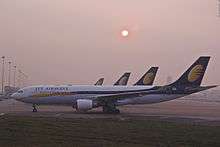
_SpiceJet._(14187865813).jpg)
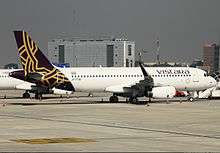

Cargo
Statistics
Top destinations
| Rank | City | Passengers | Carriers |
|---|---|---|---|
| 1 | Mumbai | 3,482,976 | Air India, Go Air, Indigo, Jet Airways, Spicejet, Vistara |
| 2 | Bangalore | 2,074,568 | AirAsia India, Air India, Go Air, Indigo, Jet Airways, Spicejet, Vistara |
| 3 | Kolkata | 1,174,986 | Air India, Go Air, Indigo, Jet Airways, Spicejet, Vistara |
| 4 | Hyderabad | 1,084,576 | Air India, Indigo, Jet Airways, Spicejet, Vistara |
| 5 | Chennai | 1,048,738 | Air India, Indigo, Jet Airways, Spicejet |
| Rank | Airport | Passengers | Annual Change | Carriers |
|---|---|---|---|---|
| 1 | Dubai | 1,864,578 | |
Air India, Air India Express, Emirates, Flydubai, Indigo, Jet Airways, Spicejet |
| 2 | London–Heathrow | 968,734 | |
Air India, British Airways, Jet Airways, Virgin Atlantic |
| 3 | Bangkok–Suvarnabhumi | 702,945 | |
Air India, Jet Airways, Thai Airways |
| 4 | Singapore | 658,792 | |
Air India, Jet Airways, Singapore Airlines |
| 5 | Kathmandu | 612,784 | |
Air India, Indigo, Jet Airways, Nepal Airlines |
| 6 | Hong Kong | 567,378 | |
Air India, Cathay Pacific, Jet Airways |
| 7 | Abu Dhabi | 560,784 | |
Air India Express, Etihad Airways, Jet Airways |
| 8 | Doha | 475,846 | |
Jet Airways, Qatar Airways |
| 9 | Frankfurt | 428,536 | |
Air India, Lufthansa |
| 10 | Kuala Lumpur | 362,938 | |
Air Asia X, Malaysia Airlines, Malindo Air |
Connectivity
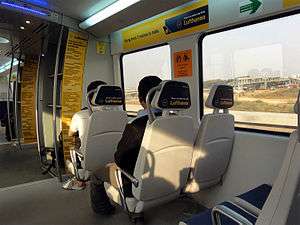

Rail
The nearest railway station is Palam railway station which is 18 km from New Delhi railway station. Several passenger trains runs regularly between these stations. Shahabad Mohammadpur (SMDP)is equally close.[42][43]
Metro
The airport is served by the Delhi Airport Metro Express train line. The 22.7 km (14.1 mi) line runs from the Airport metro station located at Terminal 3 to the New Delhi metro station railway station with trains running every 15 minutes.[44]
Road
The airport is connected by the 8-lane Delhi Gurgaon Expressway. Air conditioned low-floor buses operated by Delhi Transport Corporation (DTC) regularly run between the airport and the city. Metered taxis are also available from the terminal to all areas of Delhi.
Awards and recognitions
- In 2015, Delhi Airport bags two awards for The Best Airport in Central Asia/India and Best Airport Staff in Central Asia/India at the prestigious Skytrax World Airport Awards.[18]
- In 2015, Delhi Airport won the Best Airport award from the Airports Council International within 25–40 million annual passengers category.[17]
- In 2015, it won the prestigious Golden Peacock National Quality Award given by the Institute of Directors (India).[45]
- In 2016 The Indira Gandhi International (IGI) Airport has become Asia-Pacific’s only and one of the world’s few airports to achieve a carbon neutral status. The announcement in this regard was made by the Airports Council International (ACI) during the Airport Carbon Accreditation certificate presentation ceremony to IGI in Montreal, Canada.[46]
Accidents and incidents
- On 25 January 1970, a Royal Nepal Airlines Fokker F27-200 (9N-AAR) after a flight from Kathmandu, Nepal was caught in severe thunderstorms with turbulence and downdrafts on final approach to Palam Airport. The pilot lost control of the aircraft and crashed short of the runway. Of the five crew and 18 passengers, one crew member was killed.[47]
- 14 June 1972, Japan Airlines Flight 471 crashed outside of Palam Airport, killing 82 of 87 occupants; ten of eleven crew members and 72 of 76 passengers died, as did three people on the ground.[48]
- 31 May 1973, Indian Airlines Flight 440 crashed while on approach to Palam Airport, killing 48 of the 65 passengers and crew on board.
- On 7 May 1990, an Air India Boeing 747 flying on the London-Delhi-Mumbai route and carrying 215 people (195 passengers and 20 crew) touched down at Indira Gandhi International Airport after a flight from London Heathrow Airport. On application of reverse thrust, a failure of the no. 1 engine pylon to wing attachment caused this engine to tilt nose down. Hot exhaust gases caused a fire on the left wing. There were no casualties but the aircraft was damaged beyond repair and written off.[49]
- On 2 December 1995, Indian Airlines Flight 492 (IC 492), A Boeing 737-2A8 (Registered VT-ECS), damaged beyond repair when the aircraft overshot the runway at Delhi airport due to pilots error, on its scheduled flight from Jaipur to Delhi.[50]
- On 12 November 1996, the airport was involved in the Charkhi Dadri mid-air collision when a Saudia Boeing 747-100B, climbing out after take-off, collided with an incoming Kazakhstan Airlines Ilyushin Il-76 chartered by a fashion company, causing the deaths of all 349 people on board the two planes.[51]
- On 17 March 2016, a bomb threat was made to the airport, causing its evacuation and some flights to be canceled and delayed.[52]
Sustainability Practices
The airport is a "carbon neutral" airport.[53]
See also
- Transport in India
- List of airports in India
- List of busiest airports in India by passenger traffic
- Aviation in India
References
- ↑ "Airports Authority of India". Aai.aero. 2016-11-27. Retrieved 2016-12-02.
- ↑ "TRAFFIC STATISTICS – DOMESTIC & INTERNATIONAL PASSENGERS" (jsp). Aai.aero. Retrieved 31 December 2014.
- ↑ List of busiest airports in India by passenger traffic
- ↑ "INTERNATIONAL PASSENGERS" (PDF). OF Airports Authority of India.
- ↑ "INTERNATIONAL AIRCRAFT MOVEMENTS" (PDF). OF Airports Authority of India.
- ↑ "INTERNATIONAL FREIGHT" (PDF). OF Airports Authority of India.
- 1 2 3 4 5 6 About IGI Airport from the Wayback Machine
- ↑ eAIP India, OF Airports Authority of India, 1 April 2012
- 1 2 "Fact Sheet". Newdelhiairport.in. Retrieved 5 May 2014.
- ↑ "Delhi Airport busier than Mumbai by 40 flights a day". Indianexpress.com. 16 August 2009. Retrieved 5 May 2014.
- ↑ Grammaticas, Damian (9 May 2007). "Sky's the limit for India flight boom". BBC News. Retrieved 5 May 2014.
- ↑ "Why they should stay with the Air Force". The Hindu Business Line.
- ↑ "Mumbai, Delhi airport management to be handed over to pvt cos". Outlookindia.com. Retrieved 5 May 2014.
- ↑ "Advance System at IGIA" (Press release). Press Information Bureau, Government of India, Ministry of Civil Aviation. 12 December 2013. Retrieved 12 December 2013.
- ↑ ACI Airport Service Quality Awards 2009, Asia Pacific airports sweep top places in worldwide awards from the Wayback Machine
- ↑ "Delhi's IGI is world's 2nd best airport for service quality again". Firstpost.
- 1 2 Business Standard. "Business Standard". business-standard.com.
- 1 2 "Delhi's Indira Gandhi International Airport bags two international awards in Paris". The Economic Times. 17 March 2015. Retrieved 17 March 2015.
- ↑ "Indira Gandhi International Airport is world's best airport for second time in a row". indiatoday.intoday.in. Retrieved 2 March 2016.
- ↑ "Delhi, Mumbai airport modernisation – Efforts to ensure a smoother journey". The Hindu Business Line. Retrieved 16 July 2010.
- ↑ "Mumbai, Delhi airport management to be handed over to pvt cos". news.outlookindia.com. Retrieved 16 July 2010.
- 1 2 "Malaysia Airports Holdings Berhad". Malaysiaairports.com.my. 4 April 2006. Retrieved 16 July 2010.
- ↑ Sandeep Sharma (31 March 2010). "Equipment India – India's first infrastructure equipment magazine". Constructionupdate.com. Retrieved 16 July 2010.
- ↑ "GMR Infrastructure acquires 10% additional share in Delhi airport overall stake rises to 64%". Retrieved 18 August 2015.
- ↑ "Malaysia Airports sells Delhi International Airport stake to GMR". Retrieved 18 August 2015.
- ↑ "IGI Airport tops world in growth". Articles.timesofindia.indiatimes.com. 19 January 2008. Retrieved 5 May 2014.
- ↑ Pakistan Observer (26 November 2015). "CAA upgrades Instrument Landing System at Lahore Airport". Retrieved 26 November 2015.
- ↑ Express News Service (22 August 2008). "Air India Boeing opens Rs 1,000 cr runway at IGIA". Express India. Retrieved 29 October 2012.
- ↑ "IGI Airport to use all runways together". 5 June 2012.
- ↑ "Delhi Airport: SpiceJet and GoAir to operate from nearly defunct T2". India Today. 7 June 2016. Retrieved 13 June 2016.
- ↑ "IGI Airport in India to unveil world's third largest terminal". World Interior Design Network. Retrieved 16 July 2010.
- ↑ "Delhi International Airport (P) Limited – GMR". Gmrgroup.co.in. Retrieved 5 May 2014.
- ↑ "DIAL to invest Rs 30,000 cr, build 4 new terminals in Delhi". Economictimes.indiatimes.com. 16 April 2008. Retrieved 5 May 2014.
- ↑ "Decks cleared for shift of operations to T3". The Times of India. 11 November 2010. Retrieved 18 November 2001.
- 1 2 "Air India Express W16 new service additions". Airlineroute. Retrieved 9 November 2016.
- ↑ "Air India gears up for its maiden Bathinda to Delhi flight on Dec 11". Tribune India. Retrieved 1 December 2016.
- ↑ "Air India will start Kanpur to Delhi flight". Newstrack Live. Retrieved 1 December 2016.
- ↑ "China Airlines Cargo resumes freighter operations to India after four years | Air Cargo News". Stattimes.com. Retrieved 2016-12-02.
- ↑ "China Airlines to resume cargo services to India | Economics | FOCUS TAIWAN - CNA ENGLISH NEWS". Focustaiwan.tw. 2016-08-25. Retrieved 2016-12-02.
- ↑ "Etihad Crystal Cargo Schedule" (PDF). Retrieved 5 May 2014.
- ↑ "Jet Airways to start dedicated cargo operations from April". 17 March 2015. Retrieved 17 March 2015.
- ↑ "Shahabad Mohamadpur/SMDP Railway Station Satellite Map – India Rail Info – A Busy Junction for Travellers & Rail Enthusiasts". India Rail Info. 26 April 2010. Retrieved 24 January 2012.
- ↑ "Palam/PM Railway Station Satellite Map – India Rail Info – A Busy Junction for Travellers & Rail Enthusiasts". India Rail Info. 26 April 2010. Retrieved 24 January 2012.
- ↑ "Website Airport Metro Express Delhi". delhiairportexpress.com. Retrieved 1 December 2016.
- ↑ "Award for Delhi airport". The Hindu. 6 April 2015. Retrieved 7 April 2015.
- ↑ "IGI Airport: Carbon-neutral tag for IGI Airport, first in Asia-Pacific". Timesofindia.indiatimes.com. 2016-09-28. Retrieved 2016-12-02.
- ↑ "Aviation Safety Network retrieved 28 May 2008". Aviation-safety.net. 25 January 1970. Retrieved 5 May 2014.
- ↑ 14 JUN 1972 Douglas DC-8-53, Japan Air Lines-Aviation Safety Network; retrieved 23 March 2009.
- ↑ "Aviation Safety". Aviation Safety. Retrieved 5 May 2014.
- ↑ "Major air crashes in India in two decades". newindianexpress.com. Retrieved 1 December 2016.
- ↑ Burns, John F. (5 May 1997). "One Jet in Crash Over India Ruled Off Course". The New York Times. Retrieved 24 May 2010.
- ↑ "Boamb hoax at Delhi Airport | The New Delhi Journal". newdelhijournal.com. Retrieved 18 March 2016.
- ↑ "Know the rules of passport, visa, customs, baggage, visa extension and health for Indian Nationals and Foreign Nationals -Indira Gandhi Delhi International Airport". Newdelhiairport.in. Retrieved 2016-12-02.
External links
![]() This article incorporates public domain material from the Air Force Historical Research Agency website http://www.afhra.af.mil/.
This article incorporates public domain material from the Air Force Historical Research Agency website http://www.afhra.af.mil/.
| Wikimedia Commons has media related to Indira Gandhi International Airport. |
- Indira Gandhi International Airport, official website
- GMR Delhi International Airport Limited (DIAL)
- GMR Group
- Kanpur Airport
- Accident history for DEL at Aviation Safety Network